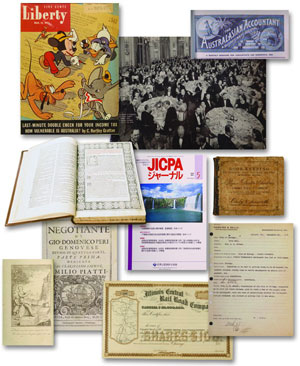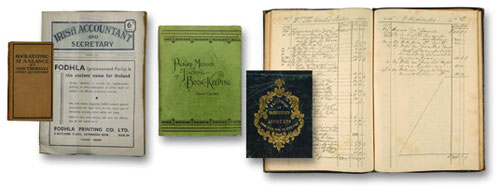
After the same frantic trip to protect the valuable collection was repeated on September 11, 2001, the day two terrorist-piloted planes hit the trade center, Deloitte & Touche principals decided the historic documents needed a safer home.
The international CPA firm presented the papers to the largest accountancy library collection in the world, housed on the UM-Oxford campus. The resources—including the oldest known accountancy book, written by Luca Pacioli in 1494—reveal much about accounting practices through the years, as well as provide a glimpse of life in general.
 The National Library of the Accountancy Profession contains more than 150,000 items, including books, journals, articles and artifacts that trace the history of accounting practices around the world. The collection serves as a central resource for researchers from around the world, and the UM library staff receive 500 to 600 queries a month.
The National Library of the Accountancy Profession contains more than 150,000 items, including books, journals, articles and artifacts that trace the history of accounting practices around the world. The collection serves as a central resource for researchers from around the world, and the UM library staff receive 500 to 600 queries a month.
“The accounting records of an individual’s business, which have survived the perilous years, enable the accounting historian to study the characteristics of earlier generations,” says Andrew Sharp, professor of accountancy at Spring Hill College in Mobile and a frequent visitor to the UM collection. “Accounting journals and ledgers contain more than mere numbers representing receipts and disbursements. They reveal what it was like to have lived in an earlier time.”
The gift from Deloitte & Touche (formerly Haskins & Sells), for example, includes letters explaining the details of more than 700 client engagements, including speculations that specific named individuals were perpetrating frauds.
“Accounting history is a worthwhile field of study because the mistakes of the past can help us avoid similar problems in the future,” says Dale Flesher, associate dean and professor at the UM Patterson School of Accountancy. “For example, the recent Enron debacle is almost identical to a similar fraud perpetrated by Ivar Kreuger during the 1920s and up to 1932. Both were the biggest bankruptcies in history at the time of their filings. Both were based on similar issues. Unfortunately, most people today were either unaware of Ivar Kreuger and his financial reporting shenanigans or didn’t think what he did could be replicated.”
When an institution can boast of the largest collection, scholars and practicing professionals alike want to see it. Four international accountancy conferences have been drawn to campus because of the accountancy library holdings. The latest was the 10th World Congress of Accounting Historians in 2004, which had previously been held in Melbourne, Madrid, London, Pisa, Sydney, Kyoto and Brussels.
UM’s prominence in accountancy library resources began to build with the 1987 acquisition of the National Tax History Research Center, an initiative credited to Tonya Flesher, former dean and current professor of accountancy. The 7,000-volume collection features documents dating to 1862. In 1993, accountancy doctoral student Tommie Singleton, now a professor at University of Alabama at Birmingham, persuaded pioneers of electronic data processing auditing to donate to the National EDP Auditing Archival Center.
A niche was in the making, and before long the National Library of the Accountancy Profession (the library of the American Institute of Certified Public Accountants, or AICPA), McMickle Accounting History Library and the Accountancy Videotape Library followed. The AICPA materials—which amounted to 150,000 pieces—came to Ole Miss in 2001 through the efforts of then-accountancy Dean James W. Davis, accountancy professors, university administration, former Mississippi Gov. Ronnie Musgrove, the Mississippi congressional delegation and a $200,000 grant from the Robert M. Hearin Foundation to move library materials to campus.
 Many of the items in the collection document the development of the federal income tax system in the United States. These materials have helped officials in other countries study the possibilities of enacting similar income taxes.
Many of the items in the collection document the development of the federal income tax system in the United States. These materials have helped officials in other countries study the possibilities of enacting similar income taxes.
At that time, AICPA Vice President Jay Rothberg said UM was chosen for the collection’s new home because of its strong technological and archival capabilities, citing the university’s renowned repository of papers belonging to Nobel laureate William Faulkner.
“The University of Mississippi is one of the nation’s most well-respected names in accountancy education,” Rothberg said when the collection was moved. “We at the AICPA are pleased that our collection will reside with an institution that has contributed so much to excellence in the profession.”
The holdings, which are housed in the university’s John D. Williams Library and Conner Hall, serve as a central resource not only for the UM accountancy school but also for university researchers and professional colleagues throughout the country and the world. The most frequent users of the resources are AICPA members who e-mail university librarians to ask specific questions, request copies of articles and request interlibrary loans. The Williams Library receives 500 to 600 contacts a month. Recent calls for information have come from Brazil, Saudi Arabia, England, Canada, Israel, Egypt, Oman, United Arab Emirates, Philippines, Czech Republic, Mexico, Lebanon, India, China, Hong Kong, Belgium and Russia, says Royce Kurtz, a UM reference librarian and associate professor.
“One of the reasons the AICPA decided to deposit its library with us was to increase the accessibility of these resources to the larger world,” Kurtz says. “We provide these historical resources not only to local scholars but also to the larger world through interlibrary loans. We hold, preserve and lend thousands of items that help scholars and researchers understand the history of accounting and business.”
Dale Flesher, who frequently draws on the library resources for his extensive research, illustrates the value of the collections and shares some intriguing aspects through these examples:
Most people correctly assume that accounting has been around for centuries, but reporting to shareholders is a product of the middle years of the 19th century. UM’s resources include the annual reports of the Illinois Central Railroad, which not only was a pioneer railroad in America but also the first big company in the nation to report to shareholders.
“The Illinois Central virtually created modern reporting to shareholders,” Flesher says. “Having the resources on campus to study the formative years of financial reporting gives us an advantage that others do not have. I also have used the library resources to study the railroad bankruptcies of the post-Civil War period. Many of the problems that were faced by the 1870s railroads were demonstrated again in the bankruptcies of savings and loan associations in the 1980s.”
The National Tax History Center (housed in Conner Hall) features thousands of books focusing on income tax in America. People from around the world come to Oxford to review materials dealing with the early years of taxation. Two scholars from Austria, for example, came to examine the problems of enacting an income tax in preparation for a similar tax in their country.
The McMickle Accounting History Library, also located in Conner Hall, boasts the largest single collection of pre-1900 accounting books in the country. Four of the volumes were authored by John Caldwell Colt, the brother of revolver inventor Samuel Colt. John Colt was a prolific accounting author and teacher in the 1830s.
Unfortunately, Colt argued with his publisher over the cost of the fifth edition of his accounting textbook and promptly killed him with an ax. He then boxed up the body and shipped it from New York to St. Louis via ship. A neighbor who overheard the argument reported it to authorities after the publisher turned up missing. Colt was sentenced to hang following what was described as the “crime of the century” in 1841.
On the day he was to go to the gallows, Colt was visited by family members. Afterwards, he was found dead of an apparent suicide; it was thought the visitors smuggled him a knife.
UM offers researchers four different editions of Colt’s work, including both a first edition and one published after he died.
The National EDP Auditing Archival Center includes the Michael P. Cangemi Collection, which contains more than 600 books on the subject of auditing information technology systems. As a result of his serving as editor and book review editor of the EDP Auditor Journal, Cangemi amassed almost all English-language auditing books written since the advent of computers. Flesher persuaded him to donate the books to the university.
Taken as a whole, the accountancy holdings are massive.
“To put the size of our collection into perspective, it should be pointed out that some universities with accounting programs subscribe to fewer than a dozen accounting journals,” Dale Flesher says. “The universities with the best doctoral programs in accounting may subscribe to between 30 and 50 journals. Our library has more than 1,300 journal titles in accountancy and finance.”
The oldest and rarest items in the collections essentially are treated as museum exhibits, says Flesher, who also is UM’s Arthur Andersen Alumni Lecturer. These include the Pacioli volume from 1494.
 The collection includes many rare volumes from around the world and original, handwritten ledgers containing client records, contracts and other information.
The collection includes many rare volumes from around the world and original, handwritten ledgers containing client records, contracts and other information.
“The librarians in the reference room tell me that some of the most heavily used items are things such as exposure drafts of new accounting principles—items that were never widely circulated,” he says. “Most accountants have copies of statements on accounting principles, but for some reason, many library patrons want to see if original exposure drafts, many of which were issued dozens of years ago, are any different from the final principles that were issued. My speculation is that these materials are being used in court cases, and the lawyers are trying to learn the original intent of a particular principle.”
Gary John Previts, professor of accountancy and associate dean for undergraduate and integrated programs at Case Western Reserve University in Cleveland, is another researcher who relies on UM’s resources.
“I travel to The University of Mississippi to make use of the collections since it is the ultimate ‘one-stop research resource’ for persons who need both scope and scale of primary and secondary research materials regarding both the professional materials needed and academic resources,” he says.
“There are always pleasant surprises—materials which had been stored away, pamphlets which have not been available and, of course, the extensive early materials which document the original printed works on accounting.”